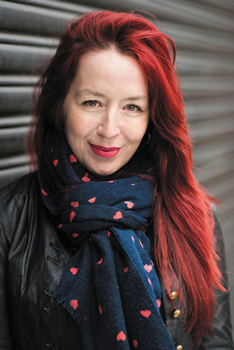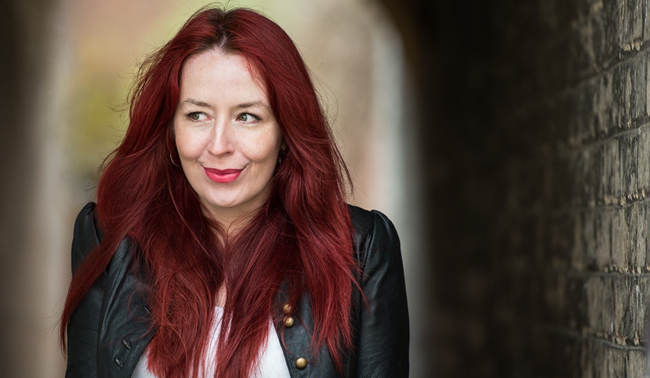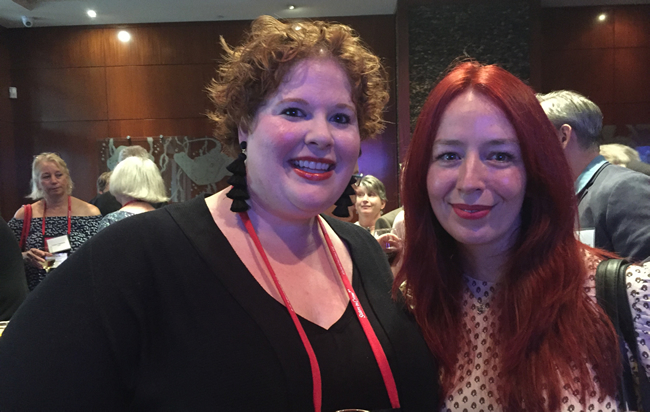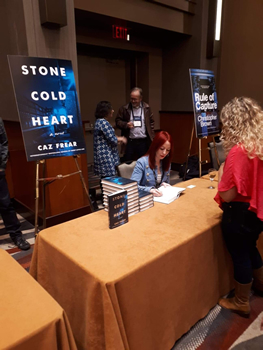

On the Cover: Caz Frear
Writing A Convincing Police Procedural
 By Dawn Ius
By Dawn Ius
Caz Frear has been obsessed with police procedurals, both on screen and off, for most of her life, but she never set out to write one—at least not intentionally. In fact, Detective Constable Cat Kinsella—the protagonist of Frear’s series of thrilling procedurals—started out as a “regular woman” who suspected her father of murder.
“I was halfway through that very early draft before I had the idea (and the confidence) to make her a detective assigned to the case,” Frear says. “I mention confidence because, while by that point I’d read hundreds and hundreds of police procedurals and I felt like I understood the mechanics of the genre, I didn’t have a police background. I didn’t even know anyone in the police force. A voice continually whispered, What makes you think you can write a convincing police procedural when you’ve never even set foot inside a police station?”
That inner voice might have frightened some writers away from the genre, but Frear had grown up watching Prime Suspect by Lynda La Plante—she wanted to be Lynda La Plante, and so rather than nudge her away from writing the police procedural of her heart, the voice threw down the gauntlet of challenge.
“Eventually I plucked up the courage to put a message out on social media—‘Hey, anyone know a police officer who’d be prepared to answer a few questions?’ And three books in, that police officer is still answering my questions,” she says. “The great thing about him is that he understands that it’s fiction, that I need to make sure I’m driving the plot forward, not just showing off my knowledge. It’s a fine line to tread. The reader needs to feel like they’re in a safe pair of hands, but not overwhelmed by procedural detail. I hope I’ve achieved that balance.”
Frear continues the precious balance she nailed in the series debut, Sweet Little Lies, with Book 3, SHED NO TEARS. In it, Cat and her partner, Luigi Parnell, are working a case when they discover a connection to a notorious serial killer who was caught and jailed. Several years prior, Christopher Masters was found guilty of abducting and killing several women—but despite eyewitness testimony against him, he never acknowledged the murder of Holly Kemp, and her body was never found.
Until now.
Cat and Luigi have an opportunity to close the case—but it’s far from open and shut, and someone very much wants it to stay unsolved.
In this interview with The Big Thrill, Frear provides insight into her creation of her young but doggedly determined protagonist, the importance of found family, and what it’s like writing and promoting during a pandemic.
It’s been a tough year—how are you holding up, both personally and professionally during the pandemic?
Well firstly, thanks for asking! I’m okay, although I still have those moments of I can’t actually believe this has happened. It still feels surreal nearly nine months on. But ultimately I’m healthy, as are my family and friends, and I’ve been lucky in the sense that I don’t have too many distractions—I don’t know how working parents coped with having their kids at home too. For me, certainly in the beginning, the main thing was finding the mental space to write. I can’t honestly say I was particularly productive for the first few months when everything seemed so new and scary, and I consumed nothing but news-feeds for the first three to four weeks. But then it’s crazy how quickly the “new normal” crept in. We humans are nothing but adaptable!
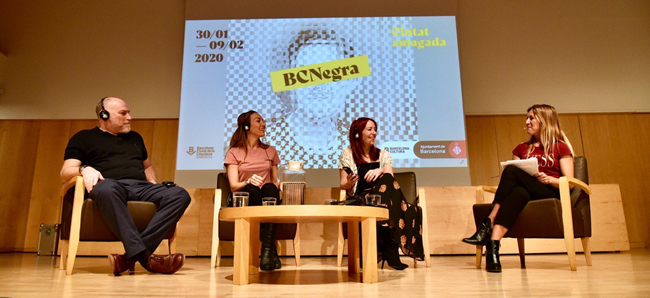
Frear participates in a panel at Barcelona Negra 2020 with “Tartan noir” author Alan Parks, dancer-turned-crime novelist Katrine Engberg, and moderator Laura González.
Obviously with a police procedural there is crime, but family—“found family” in particular—is an important underlying theme in this series. Why is that important to you to write about, and how does it inform Cat’s character?
Cat is a young woman whose mother is dead, who’s estranged from her father, and who has a difficult relationship with both of her siblings, so it gave me two obvious options—make her a damaged loner who finds it difficult to form meaningful relationships (which is certainly a crime fiction trope), or give her a new “family”—her work colleagues. I opted for the latter because there is SO much drama in Cat’s personal life, I felt she needed a safe haven. I felt her character needed to be rounded out—softened a little, I guess. While she can be quite dry and sometimes brittle, her love for her “work-dad” Parnell and her huge respect for Steele shows the reader her vulnerable side.
I also truly believe that despite some of the bad decisions Cat makes, she is a good person, and good people don’t exist in vacuums. They make connections. They love and they’re loved. I didn’t want Cat to be entirely defined by her dysfunctional upbringing.
And finally, having lived in London for 14 years, away from my family, I know firsthand that you do find yourself forming very strong relationships with the people you work with. I mean, you see these people five days a week—you fight, you make up, you celebrate, you commiserate, you make each other coffee, you moan about work. I wanted to show a realistic working environment, something most readers can relate to.
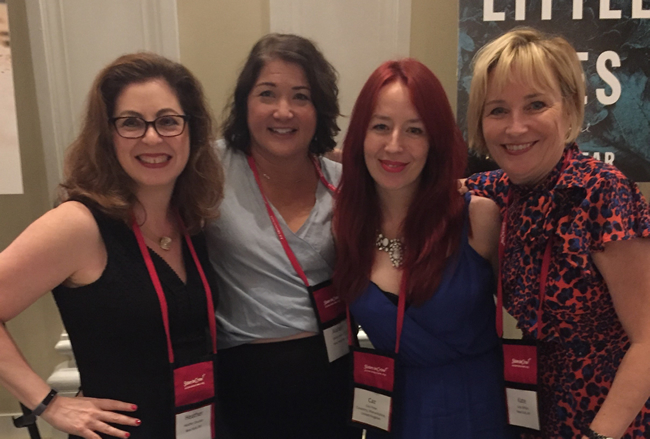
Frear with Harper Senior Director of Publicity Heather Drucker, Alafair Burke, and Kate White at Bouchercon 2018.
We begin with a whopper of a case in SHED NO TEARS. What was the inspiration for this book?
This is actually quite hard to answer as going into too much detail could lead to spoilers, so I’ll keep it broad! With SHED NO TEARS I wanted to explore the fallibility of the police—not to show them in a negative light, but to reinforce this idea that these are hard-working, highly competent people, but they are just that—people. And people under pressure make mistakes. They make bad calls. They back themselves into corners they can’t get out of.
“The Roommate” case itself is entirely fictional, but I did read a lot around the case of the “Suffolk Strangler”—a guy in the UK who killed five women over a short period before he was caught. The case completely dominated our TV screens for a few months, and then like most things, it faded from public consciousness. Sadly, I think a lot of people would be hard-pushed to remember the victims’ names now, although they’d certainly remember the case. I also thought it would be interesting to portray a so-called “unlikeable” female murder victim—to explore how they’re portrayed in the media and how this can affect murder investigations. It’s a really sad, frustrating fact that “wholesome,” “likeable,” “girl next door” murder victims are still deemed more newsworthy.
Cat is one of the most relatable protagonists I’ve read in a long time. How did her character form in your mind? Did you intend for her to be a series character?
That’s so great to hear as it’s the one thing I consciously set out to do with Cat—I wanted her to be an everywoman, not a “supercop.” I knew she’d have baggage, of course, but I also wanted her to be able to laugh at herself, to form friendships, to be someone that anyone from 18 to 80 could relate to in some small way. While murder detectives do extraordinary jobs, they are just regular people like the rest of us. They pay bills, go grocery shopping, watch TV, moan about their kids, etc. And while the superhero-lone-wolf-cop can be lots of fun, I’m always aware that I’m reading fiction when I’m absorbed in a book like that. I like my readers to feel like they’re actually part of Cat’s team, or at least a fly on the wall. To do that you need characters who people recognize from real life.
Cat’s voice came to me pretty easily. My husband always says that he can hear me when Cat is talking, and I do accept that to a degree. I think if you write in the “first person present tense,” it’s inevitable that tiny bits of your personality will bleed into the character, but ultimately Cat’s life experiences are very different than mine (apart from the Irish background!).
And yes, I did always see her as a series character. It’s why I made her a relatively young, low-ranking officer. Firstly—it’s the low-ranking officers who do most of the interesting work (interviewing, chasing down leads, etc.) but secondly, it meant that she could really grow as a character. She’s definitely grown up a little, emotionally, since the events of Sweet Little Lies.
Authors often talk about how book two is harder to write than the first, and I know you struggled with it—but did the process get easier with SHED NO TEARS? And if so, how?
Not really! But I think most writers would agree that it never gets easier because you have to keep challenging yourself. You want each book to feel distinct.
It was easier in the sense that by SHED NO TEARS, I knew the characters inside out—how they relate to each other, their humor, how they move, everything. But I think SHED NO TEARS probably has the most ambitious plot of the three, and that was definitely a head-wreck at times.
Having said that, now I’m in the weeds with Book 4, I look back thinking “God, SHED NO TEARS was easy compared to this.” I think it’ll always be that way. Nothing is ever as frustrating as the book you’re currently writing.
Obviously promotion is different in times of a pandemic. How are you adapting?
Overall, it’s been fine, if not ideal (where would we be without Zoom?). There’s been plenty of opportunities for promotion, and I’ve been so impressed with how well and how quickly the publishing industry has adapted. I’ve taken part in one-on-one interviews, I’ve been on panels, I’ve done online readings, I’ve been part of online festivals, and it’s all been great fun. You can’t beat human contact, though. Meeting readers is one of the most fun parts of this job, and sadly that’s the part that’s suffered most.
Of course we want each book to resonate with readers, but you have the added bonus of having readers really gravitate toward your writing. Craft is clearly important to you—SHED NO TEARS is virtually flawless. What are the important aspects of storytelling for you?
That’s incredibly kind of you! It’s honestly hard to pick the most important aspects because, as a writer, you strive to achieve it all. But what I would say is I am a HUGE plotter. I’m in awe of authors who just start with a premise and see where it leads. I spend a few months working out every twist and turn—and I mean every twist and turn—before I start writing the actual story. My Draft Zero is basically an Excel document! I think because I’m aware that my novels are very character-driven, and that character and “voice” comes easily, I need to be very conscious of plot and pace. I need to make sure that I’m not just spending the whole time in Cat’s head—that there is a gripping story to tell.
On character, I’d say motivation is the key thing. It’s certainly a make or break for me as a reader. While it is fiction, and while Cat certainly does have experiences that the average reader won’t have had, I think you have to believe in why a character is doing what they’re doing. For me, there’s nothing worse than watching a character behave in a way that goes against what 99 percent of people would do in that same situation. It’s the old horror movie thing—why on earth would the heroine go and investigate a sound in the woods with a stuttering torch and no phone signal? You just wouldn’t do it! That kind of stuff drives me mad. At the very least I want the reader to think, Okay, well, maybe that’s at odds with what I’d do, but I can understand why she did it.
Bringing a scene to life is also so important to me. It doesn’t have to be stunning descriptive prose (and I don’t think that’s my strong point), but there needs to be small, sharp details that root the reader in the scene. It’s the fly-on-the-wall thing again, I guess.
What can you share about what you are working on next? Will it be another Cat Kinsella book?
No, and it’s been very odd putting Cat to bed for a well-earned rest!
I’m writing a standalone thriller next—actually, it’s probably more psychological suspense than a “thriller,” although I lose track of what the terms mean. It’s about a woman who believes she’s one of life’s “good people,” but when she realizes that someone very close to her is plotting her demise, she has to revisit several incidents from her past where she might have inadvertently caused someone lasting damage. I think of it as the opposite of It’s a Wonderful Life, in that it runs with the idea that our actions, however small (and unintentional), can sometimes do huge damage to other people without us ever realizing. The working title is Five Bad Deeds, but that could well change.
- On the Cover: Alisa Lynn Valdés - March 31, 2023
- On the Cover: Melissa Cassera - March 31, 2023
- Behind the Scenes: From Book to Netflix - March 31, 2023

